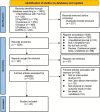Effect of Latin dance on physical and mental health: a systematic review
- PMID: 37434149
- PMCID: PMC10337058
- DOI: 10.1186/s12889-023-16221-6
Effect of Latin dance on physical and mental health: a systematic review
Abstract
Background: Latin dance is a well-liked physical activity. It has gained increasing attention as an exercise intervention for improving physical and mental health outcomes. This systematic review examines the effects of Latin dance on physical and mental health.
Methods: Preferred Reporting Items for Systematic Reviews and Meta-analysis (PRISMA) were used to report the data for this review. To gather research from the literature, we used recognized academic and scientific databases such SportsDiscus with Full Text, PsycINFO, Cochrane, Scopus, PubMed, and Web of Science. The systematic review only included 22 studies out of the 1,463 that matched all inclusion criteria. The PEDro scale was used to rate each study's quality. 22 research received scores between 3 and 7.
Results: Latin dance has been demonstrated to promote physical health by helping people lose weight, improve cardiovascular health, increase muscle strength and tone, and improve flexibility and balance. Furthermore, Latin dance can benefit mental health by reducing stress, improving mood, social connection, and cognitive function.
Conclusions: Finding from this systematic review provide substantial evidence that Latin dance has effect on physical and mental health. Latin dance has the potential to be a powerful and pleasurable public health intervention.
Systematic review registration: CRD42023387851, https://www.crd.york.ac.uk/prospero .
Keywords: Exercise intervention5; Latin dance1; Mental health4; Physical activity2; Physical health3; Public health6.
© 2023. The Author(s).
Conflict of interest statement
The authors declare that they have no competing interests.
Figures
Similar articles
-
Effects of active video games on mental health among college students: a systematic review.BMC Public Health. 2024 Dec 18;24(1):3482. doi: 10.1186/s12889-024-21011-9. BMC Public Health. 2024. PMID: 39695572 Free PMC article.
-
Evidence of the Effects of Dance Interventions on Adults Mental Health: A Systematic Review.J Dance Med Sci. 2023 Dec;27(4):183-193. doi: 10.1177/1089313X231178095. Epub 2023 Jun 7. J Dance Med Sci. 2023. PMID: 37287281
-
Dance for Adults With Fibromyalgia-What Do We Know About It? Protocol for a Scoping Review.JMIR Res Protoc. 2017 Feb 22;6(2):e25. doi: 10.2196/resprot.6873. JMIR Res Protoc. 2017. PMID: 28228371 Free PMC article.
-
A systematic review of mental health in rural Andean populations in Latin America during the COVID-19 pandemic.Front Psychiatry. 2023 Aug 17;14:1136328. doi: 10.3389/fpsyt.2023.1136328. eCollection 2023. Front Psychiatry. 2023. PMID: 37663592 Free PMC article.
-
Association of Dance-Based Mind-Motor Activities With Falls and Physical Function Among Healthy Older Adults: A Systematic Review and Meta-analysis.JAMA Netw Open. 2020 Sep 1;3(9):e2017688. doi: 10.1001/jamanetworkopen.2020.17688. JAMA Netw Open. 2020. PMID: 32975570 Free PMC article.
Cited by
-
Effects of Pilates on Body Posture: A Systematic Review.Arch Rehabil Res Clin Transl. 2024 May 21;6(3):100345. doi: 10.1016/j.arrct.2024.100345. eCollection 2024 Sep. Arch Rehabil Res Clin Transl. 2024. PMID: 39372244 Free PMC article. Review.
-
Effects of a 16-week dance intervention on loneliness and self-esteem in left behind children: a randomised controlled trial.Sci Rep. 2025 Jan 25;15(1):3268. doi: 10.1038/s41598-025-87954-0. Sci Rep. 2025. PMID: 39863795 Free PMC article. Clinical Trial.
-
Effect of dance on social physique anxiety and physical self-esteem among adults: a systematic review.Front Psychol. 2025 Jun 4;16:1547802. doi: 10.3389/fpsyg.2025.1547802. eCollection 2025. Front Psychol. 2025. PMID: 40535192 Free PMC article.
-
Effect of Dancing Interventions on Depression and Anxiety Symptoms in Older Adults: A Systematic Review and Meta-Analysis.Behav Sci (Basel). 2024 Jan 10;14(1):43. doi: 10.3390/bs14010043. Behav Sci (Basel). 2024. PMID: 38247695 Free PMC article. Review.
-
Effects of a 12-week dance intervention on left-behind children with co-occurring social anxiety and low self-concept.Front Psychol. 2025 Apr 25;16:1491743. doi: 10.3389/fpsyg.2025.1491743. eCollection 2025. Front Psychol. 2025. PMID: 40351585 Free PMC article.
References
-
- Purcell K, Taylor J, West K, Haynes A, Hassett L, Sherrington C. Promotion of physical activity by health professionals in a sample of six public hospitals: a cross sectional study. Health Promotion Journal of Australia 2023. - PubMed
-
- Jain RK, Vokes T. Physical activity as measured by accelerometer in NHANES 2005–2006 is associated with better bone density and trabecular bone score in older adults. Archives of Osteoporosis 2019, 14(1). - PubMed
Publication types
MeSH terms
LinkOut - more resources
Full Text Sources
Medical
Miscellaneous


